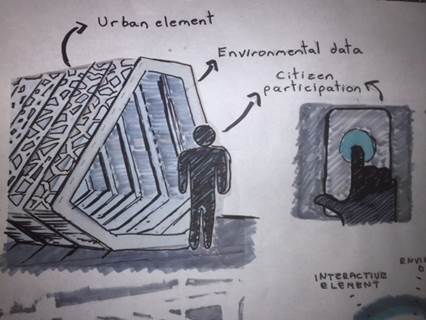CONCEPTUALIZATION
My first idea was to develop a interactive element for citizen participation in the public spaces. Obtain data of citizen
to facilitate decision-making in urban planning.


An important environmental data in public spaces refers to temperature. Thermal comfort is a decisive factor for the well-being of the users of the space. Finally I decided to focus my final project on the subject of thermal comfort.

INSPIRATION
For the approach of my possible final project, I was inspired by some initiatives. Fab City / Totems-FabLab Santiago / Smart citizen / Fab Condenser

THE PROBLEM
In the city of Merida, temperatures are high, so it is almost impossible to enjoy public spaces during the day. The absence of thermal comfort data in public spaces has ocassioned that not considered strategies to combat it.
Another problem arises when research centers want to work on thermal comfort indexes and equipment is expensive. This causes that the samples are not representative since only one or two monitoring devices are available.
<
Background
Human thermal comfort is defined as a condition of mind, which expresses satisfaction with the surrounding environment. High temperatures and humidity provide discomfort sensations and sometimes heat stress (i.e., reducing the body’s ability to cool itself). Moreover, discomfort and heat stress reduce productivity of workers and may lead to more serious health problems, especially for aged persons. In hot summer seasons of arid regions, high outdoor air temperatures due to intensive solar radiation and low relative humidity are present. Consequently, discomfort sensations and heat stress are expected. Therefore, persons should take care when they go outside in hot summer to protect their health from heat and/or sunstroke.
THE PROJECT: HEAT STRESS DEVICE
Develop a map of open data of thermal stress in public spaces that show environmental data and perception of thermal comfort of citizens. The municipal authorities can take specific measures in these places to protect residents from the health risks of heat stress. These measures can be revitalization interventions through shading elements in public spaces or other strategies.

SCOPE
For reasons of time, the scope of the project is the development of the device. The plataform of data visualization on maps is not considered.
The indicator chosen to measure heat stress is the WetBulb Globe Temperature (WBGT). This is a measure of the heat stress in direct sunlight, which takes into account: temperature, humidity, wind speed, sun angle and cloud cover (solar radiation).
MATERIALS AND PROCEDURE
Inputs required:
Natural wet-bulb temperature (Tw)
Globe thermometer temperature (Tg)
Dry-bulb temperature (Td)
Outputs:
WBGT: WetBulb Globe Temperature
It is derived from the following formula:
WBGT =0.7Tw+0.2Tg+0.1Td
Principal components:
Adafruit AMG8833 IR Thermal Camera
Arduino
Natural wet-bulb temperature sensor
Globe thermometer temperature sensor
Dry-bulb temperature sensor
LCD
Others componentes

Software:
Arduino | Processing | Rhinoceros
Machines and Tools:
3d printer | Laser cut | MonoFab SRM-20 | Basic equipment for welding
IN THE FUTURE
In addition to the thermal indicator obtained, it is desirable that the device contains a question to assess the perception of thermal comfort of people.
Example:
What is your current thermal comfort: 1. Hot 2. Warm 3. Slightly Warm 4. Neutral 5. Slightly Cool 6. Cool 7. Cold
 Source: Ekici, Can. (2013). A review of thermal comfort and method of using Fanger's PMV equation. 5th International Symposium on Measurement, Analysis and Modelling of Human Functions, ISHF 2013. 61-64.
Source: Ekici, Can. (2013). A review of thermal comfort and method of using Fanger's PMV equation. 5th International Symposium on Measurement, Analysis and Modelling of Human Functions, ISHF 2013. 61-64.
It may also contain a thermal camera to give a first idea of the physical elements of the external environment
